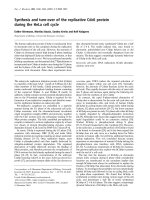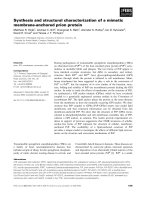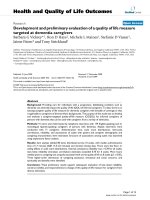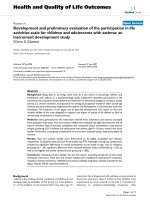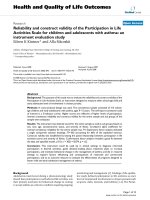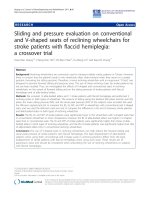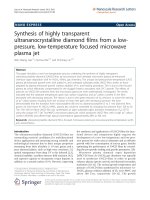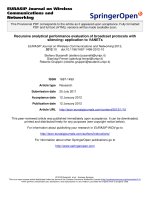Báo cáo toán học: " Synthesis and anti-HSV-1 evaluation of new " docx
Bạn đang xem bản rút gọn của tài liệu. Xem và tải ngay bản đầy đủ của tài liệu tại đây (215.81 KB, 24 trang )
This Provisional PDF corresponds to the article as it appeared upon acceptance. Fully formatted
PDF and full text (HTML) versions will be made available soon.
Synthesis and anti-HSV-1 evaluation of new
3H-benzo[b]pyrazolo[3,4-h]-1,6-naphthyridines and
3H-pyrido[2,3-b]pyrazolo[3,4-h]-1,6-naphthyridines
Organic and Medicinal Chemistry Letters 2012, 2:3 doi:10.1186/2191-2858-2-3
Alice M R Bernardino ()
Alexandre R Azevedo ()
Luiz C S Pinheiro ()
Julio C Borges ()
Izabel C P Paixao ()
Milene Mesquita ()
Thiago M L Souza ()
Mauricio S dos Santos ()
ISSN 2191-2858
Article type Original
Submission date 28 September 2011
Acceptance date 1 February 2012
Publication date 1 February 2012
Article URL />This peer-reviewed article was published immediately upon acceptance. It can be downloaded,
printed and distributed freely for any purposes (see copyright notice below).
For information about publishing your research in Organic and Medicinal Chemistry Letters go to
/>For information about other SpringerOpen publications go to
Organic and Medicinal
Chemistry Letters
© 2012 Bernardino et al. ; licensee Springer.
This is an open access article distributed under the terms of the Creative Commons Attribution License ( />which permits unrestricted use, distribution, and reproduction in any medium, provided the original work is properly cited.
1
Synthesis and anti-HSV-1 evaluation of new 3H-benzo[b]pyrazolo[3,4-h]-
1,6-naphthyridines and 3H-pyrido[2,3-b]pyrazolo[3,4-h]-1,6-
naphthyridines
Alice M R Bernardino
1
, Alexandre R Azevedo
1
, Luiz C S Pinheiro
1
, Júlio C Borges
1
,
Izabel C P Paixão
2
, Milene Mesquita
2,3
, Thiago M L Souza
2,3
and Maurício S dos Santos
*4
1
Departamento de Química Orgânica, Instituto de Química, Programa de Pós-Graduação
em Química, Universidade Federal Fluminense, Campus do Valonguinho, 24020-150,
Niterói, RJ, Brazil
2
Departamento de Biologia Celular e Molecular, Instituto de Biologia, Universidade
Federal Fluminense, Campus do Valonguinho, 24020-150, Niterói, RJ, Brazil
3
Programa de Pós-Graduação em Biologia Celular e Molecular, Fundação Oswaldo Cruz,
Instituto Oswaldo Cruz, 21040-900, Rio de Janeiro, RJ, Brazil
4
Departamento de Física e Química, Instituto de Ciências Exatas, Universidade Federal
de Itajubá, 37500-903, Itajubá, MG, Brazil
*
Corresponding author:
Email addresses:
AMRB:
ARA:
LCSP:
JCB:
ICPP:
MM:
2
TMLS:
Abstract
Background: Herpes simplex virus type-1 (HSV-1) is the primary cause of facial lesions
(mouth, lips, and eyes) in humans. The widespread use of acyclovir and nucleoside
analogues has led to emergence of HSV strains that are resistant to these drugs. Recently,
non-nucleoside anti-HSV compounds have received considerable attention. 1,6-
Naphthyridines are a class of heterocyclic compounds that exhibit a broad spectrum of
biological activities such as inhibitor of HIV-1 integrase, HCMV, FGF receptor-1
tyrosine kinase, and the enzyme acetylcholinesterase. We previously reported the
synthesis, SAR studies, and evaluation anti-HSV-1 activity of 3H-benzo[b]pyrazolo[3,4-
h]-1,6-naphthyridines. In the course of our search for new 1,6-naphthyridines derivatives
with potential activity against HSV-1, we have synthesized and evaluated new 3H-
benzo[b]pyrazolo[3,4-h]-1,6-naphthyridines (1a–k) and 3H-pyrido[2,3-b]pyrazolo[3,4-h]-
1,6-naphthyridines (2a–c).
Results: A known synthetic approach was used for preparing new 3H-
benzo[b]pyrazolo[3,4-h]-1,6-naphthyridines (1a–k) and 3H-pyrido[2,3-b]pyrazolo[3,4-h]-
1,6-naphthyridines (2a–c), starting from ethyl 4-chloro-1-phenyl-1H-pyrazolo[3,4-
b]pyridine-5-carboxylate (7). All compounds were identified by FTIR,
1
H NMR, and
mass spectrometry. The antiviral effect on HSV-1 virus replication was determined.
Conclusions: The compounds 1d, 1f, 1g, and 1h exhibited the highest anti-HSV-1
activity. In general, 3H-benzo[b]pyrazolo[3,4-h]-1,6-naphthyridines were more effective
inhibitors than their corresponding 3H-pyrido[2,3-b]pyrazolo[3,4-h]-1,6-naphthyridines.
The compound 1h reduced the virus yield in 91% at 50 µM and exhibited a low
cytotoxicity (CC
50
600 µM).
Keywords: HSV-1; 1,6-naphthyridines; pyrazolonaphthyridines; heterocycles.
3
Background
Herpes simplex virus type-1 (HSV-1) is a large enveloped virus containing double-
stranded DNA genomes of approximately 152 kb in size. HSV-1 is the primary cause of
facial lesions (mouth, lips, and eyes) in humans [1, 2]. Most of clinical anti-herpes virus
compounds are nucleoside analogues, such as acyclovir (ACV), which is the most
common drug used on treatment of HSV infections [3–5]. However, the widespread use
of these compounds has been associated with the emergence of drug-resistant HSV
strains [5]. The discovery of new non-nucleoside anti-HSV-1 agents with different
mechanisms of action could offer an additional strategy against drug resistance of viruses.
Several examples of non-nucleoside inhibitors have been proposed as candidate drugs for
the treatment of herpes [3, 6–11].
1,6-Naphthyridines are a class of heterocyclic compounds that exhibit a broad spectrum
of biological activities such as inhibitor of HIV-1 integrase [12–15], HCMV [16, 17],
FGF receptor-1 tyrosine kinase [18], and the enzyme acetylcholinesterase [19]. Many
routes for the syntheses of 1,6-naphthyridines derivatives have previously been reported
[20–24].
Recently, our research group reported the synthesis, SAR studies, and evaluation anti-
HSV-1 activity of 3H-benzo[b]pyrazolo[3,4-h]-1,6-naphthyridines derivatives I
(Figure 1) [25]. In the course of our search for new 1,6-naphthyridines derivatives with
potential activity against HSV-1, we have synthesized and evaluated new 3H-
benzo[b]pyrazolo[3,4-h]-1,6-naphthyridines (1a–k) and 3H-pyrido[2,3-b]pyrazolo[3,4-h]-
1,6-naphthyridines (2a–c) (Scheme 1).
4
Results and discussion
Chemistry
A known synthetic approach was used for preparing the 3H-benzo[b]pyrazolo[3,4-h]-1,6-
naphthyridines (1a–k) and 3H-pyrido[2,3-b]pyrazolo[3,4-h]-1,6-naphthyridines (2a–c),
starting from ethyl 4-chloro-1-phenyl-1H-pyrazolo[3,4-b]pyridine-5-carboxylate (7)
(Scheme 1) [26–28]. In the first step, ethyl α-carboethoxy-β-(5-
pyrazolylammonium)acrylate (8) was prepared by the condensation between 5-amino-1-
phenyl-1H-pyrazole (9) and diethyl ethoxymethylenemalonate, in ethanol. The
cyclization of the acrylate 8 was carried out by refluxing in phosphorus oxychloride to
afford 4-chloro1-phenyl-1H-pyrazolo[3,4-b]pyridine-5-carboxylate (7) in 75% yield [26–
28]. Nucleophilic displacement of the chlorine atom in compound 7 by aromatic amines
gave ethyl 4-(arylamino)-1-phenyl-1H-pyrazolo[3,4-b]pyridine-5-carboxylates (5a–k) in
yields 52–82% [26, 29]. Similarly, aminopicolines were used to obtain ethyl 4-
[(methylpyridin-2-yl)amino]-1-phenyl-1H-pyrazolo[3,4-b]pyridine-5-carboxylates (6a–c)
in yields 50–60%. These were achieved by heating at 140°C without solvents for 2–4 h an
equimolar mixture of the appropriate aniline or aminopicoline and the compound 7.
However, better results were obtained when these reactions were carried out in solvents
such as DMF [25]. Subsequent hydrolysis of the esters 5a–k and 6a–c afforded the
corresponding 4-(arylamino)-1-phenyl-1H-pyrazolo[3,4-b]pyridine-5-carboxylic acids
(3a–k) and 4-[(methylpyridin-2-yl)amino]-1-phenyl-1H-pyrazolo[3,4-b]pyridine-4-
carboxylic acids (4a–c), in high yields, 86–93 and 80–93%, respectively [28]. For
producing 3H-benzo[b]pyrazolo[3,4-h]-1,6-naphthyridines (1a–k) and 3H-pyrido[2,3-
b]pyrazolo[3,4-h]-1,6-naphthyridines (2a–c), the respective carboxylic acids 3a–k and
4a–c were cyclized with phosphorus oxychloride at 110°C over a period of 3 h [25, 30].
The tetracyclic compounds 1a–k and 2a–c were isolated in 60–70% yield.
5
Biological evaluation
The targets 3H-benzo[b]pyrazolo[3,4-h]-1,6-naphthyridines (1a–k) and 3H-pyrido[2,3-
b]pyrazolo[3,4-h]-1,6-naphthyridines (2a–c) were evaluated for inhibition of HSV-1
replication in infected Vero cells. Results are shown in Table 1. Compounds 1d, 1f, 1g,
and 1h exhibited the highest anti-HSV-1 activity. Compound 1h reduced the virus yield
in 91% at 50 µM. In general, 3H-benzo[b]pyrazolo[3,4-h]-1,6-naphthyridines (1a–k)
were more effective inhibitors than their corresponding 3H-pyrido[2,3-b]pyrazolo[3,4-h]-
1,6-naphthyridines (2a–c).
Compounds with nearly the same antiviral effects were evaluated for cytotoxicity in Vero
cells. EC
50
and the selectivity index (SI) were determined in parallel. Several of the new
compounds prevented the cytopathic effect of HSV-1 in Vero cells, at micromolar
concentrations, and were minimally toxic to Vero cells resulting in a good SI. The MTT
assay indicated that compound 1h exhibited a low cytotoxicity (CC
50
600 µM). Trypan
blue and MTT showed similar results (data not shown). ACV results have been included
for comparison purposes (Table 2).
Conclusions
In summary, a new series of 3H-benzo[b]pyrazolo[3,4-h]-1,6-naphthyridines (1a–k) and
3H-pyrido[2,3-b]pyrazolo[3,4-h]-1,6-naphthyridine (2a–c) were synthesized and some of
them were potent anti-HSV-1 agents. The compounds 1d, 1f, 1g, and 1h exhibited the
highest anti-HSV-1 activity, being the 3H-benzo[b]pyrazolo[3,4-h]-1,6-naphthyridine
derivatives, in general, more effective inhibitors than their corresponding 3H-pyrido[2,3-
b]pyrazolo[3,4-h]-1,6-naphthyridines. The compound 1h reduced the virus yield in 91%
at 50 µM and exhibited a low cytotoxicity (CC
50
600 µM). The mechanism of antiviral
activity of these compounds is under investigation.
6
Experimental
Melting points were determined on a Fisatom 430D and are uncorrected.
1
H NMR spectra
were recorded on a Varian Unity Plus spectrometer for 300 MHz, with tetramethylsilane
as the internal standard. Chemical shifts (δ) are reported in parts per million (ppm) and
the coupling constants (J) in Hertz (Hz). Fourier transform infrared absorption spectra
were recorded in a Perkin-Elmer Spectrum One FTIR spectrophotometer. The solid
samples were measured using potassium bromide (KBr) pellets. Thin-layer
chromatography was performed on Uniplates (silica gel). All chemicals were reagent
grade. High-resolution mass spectral analysis was recorded using a Finingan MAT 711A.
General procedures for the synthesis of 3H-benzo[b]pyrazolo[3,4-h]-1,6-
naphthyridine derivatives (1a–k), and 3H-pyrido[2,3-b]pyrazolo[3,4-h]-1,6-
naphthyridine derivatives (2a–c)
The key intermediate ethyl 4-chloro-1-phenyl-1H-pyrazolo[3,4-b]pyridine-5-carboxylate
(7) was prepared according to literature [26–28]. An equimolar mixture of 7 (4 mmol)
and anilines or aminopicolines in 10 mL DMF was heated under reflux for 2–4 h. The
reaction mixture, after cooling, was poured into 50 mL of ice-water. The precipitated was
filtered, dried, and recrystallized from a mixture of ethanol and water. The compounds
obtained 5a–k and 6a–c were reacted with 10 mL NaOH (20%) and 10 mL of ethanol
under reflux for 1–3 h. On cooling to room temperature, the mixture was acidified with
diluted hydrochloric acid (1:3), and the precipitate was filtered and recrystallized from
DMF and water. A mixture of the acids 3a–k and 4a–c (1 mmol), and phosphorus
oxychloride (5 mL) was heated under reflux for 3 h. The reaction mixture was inverted
over crushed ice. In some cases the excess of phosphorus oxychloride was removed under
7
reduced pressure before inverting over crushed ice and neutralized. The new compounds
1a–k and 2a–c were isolated in yields 60–70%. The resulting precipitate was collected
and purified by flash column chromatography (FC, silica gel). The structures of the
compounds were elucidated by FTIR,
1
H NMR, and mass spectrometry.
(1a) 6-chloro-3-phenyl-3H-benzo[b]pyrazolo[3,4-h]-1,6-naphthyridine
Yield 70%; mp 259–260°C; IR (KBr, cm
-1
) ν
max
C–H 3084, C=C 1596, C=N 1502;
1
H
NMR (DMSO-d6, 300 MHz) δ 8.92 (1H, s, H-1), 8.40 (1H, d, J = 8.1 Hz, H-10), 7.95
(1H, dd; J = 8.1 Hz, H-9), 7.70 (1H, dd, J = 8.1 Hz, H-8), 7.81 (1H, d, J = 8.1 Hz, H-7),
9.40 (1H, s, H-5), 8.33 (2H, d, J = 7.5 Hz, H-2’,H-6’), 7.50 (2H, t, J = 7.5 Hz, H-3’, H-
5’), 7.52 (1H, t, J = 7.5 Hz, H-4’); EI (70eV) m/z (%): M
+
330.00761 (100).
(1b) 6-chloro-3-phenyl-9-methoxy-3H-benzo[b]pyrazolo[3,4-h]-1,6-naphthyridine
Yield 68%; mp >300°C; IR (KBr, cm
-1
) ν
max
C–H 3083, C=C 1595, C=N 1504;
1
H NMR
(DMSO-d6, 300 MHz) δ 8.99 (1H, s, H-1), 7.26 (1H, s, H-10), 7.78–7.56 (5H, m, H-3′,H-
4′,H-5′,H7,H-8), 9.36 (1H, s, H-5), 8.31 (2H, d, J = 8.0 Hz, H-2′,H-6′), 4.07 (3H, s, Ar-
OCH
3
); EI (70 eV) m/z (%): M
+.
360.07037 (100).
(1c) 6-chloro-3-phenyl-9-methyl-3H-benzo[b]pyrazolo[3,4-h]-1,6-naphthyridine
Yield 65%; mp >300°C; IR (KBr, cm
-1
) ν
max
C–H 3083, C=C 1595, C=N 1503;
1
H NMR
(DMSO-d6, 300 MHz) δ 8.99 (1H, s, H-1), 7.79–7.57 (6H, m, H-3′,H-4′,H-5′,H7,H-8,H-
10), 9.42 (1H, s, H-5), 8.40 (2H, d, J = 8.4 Hz, H-2′,H-6′), 1.39 (3H, s, Ar-CH
3
); EI
(70eV) m/z (%): M
+.
344.81022 (100).
8
(1d) 6,9-dichloro-3-phenyl-3H-benzo[b]pyrazolo[3,4-h]-1,6-naphthyridine
Yield 60%; mp >300°C; IR (KBr, cm
-1
) ν
max
C–H 3082, C=C 1598, C=N 1503;
1
H NMR
(DMSO-d6, 300 MHz) δ 9.08 (1H, s, H-1), 7.99–7.53 (6H, m, H-3′,H-4′,H-5′,H7,H-8,H-
10), 9.38 (1H, s, H-5), 8.41 (2H, d, J = 8.4 Hz, H-2′,H-6′); EI (70 eV) m/z (%): M
+.
364.01693 (100).
(1e) 6,8-dichloro-3-phenyl-3H-benzo[b]pyrazolo[3,4-h]-1,6-naphthyridine
Yield 68%; mp >300°C; IR (KBr, cm
-1
) ν
max
C–H 3084, C=C 1598, C=N 1503;
1
H NMR
(DMSO-d6, 300 MHz) δ 8.97 (1H, s, H-1), 7.87 (1H, d, J = 8.1 Hz, H-10), 7.89 (1H, d,
J = 8.1 Hz, H-9), 8.22 (1H, s, H-7), 9.31 (1H, s, H-5), 8.27 (2H, d, J = 8.1 Hz, H-2′,H-6’),
7.46 (2H, dd, J = 7.5 Hz, H-3′,H-5′), 7.65 (1H, t, J = 7.5 Hz, H-4′); EI (70 eV) m/z (%):
M
+.
364.01789 (100).
(1f) 6-chloro-3-phenyl-9-nitro-3H-benzo[b]pyrazolo[3,4-h]-1,6-naphthyridine
Yield 60%; mp >300°C; IR (KBr, cm
-1
) ν
max
C–H 3084, C=C 1596, C=N 1503;
1
H NMR
(DMSO-d6, 300 MHz) δ 8.92 (1H, s, H-1), 8.84 (1H, s, H-10), 8.05 (1H, d, J = 7.5 Hz,
H-8), 8.02 (1H, d, J = 7.5 Hz, H-7), 9.40 (1H, s, H-5), 8.31 (2H, d, J = 7.5 Hz, H-2′,H-6′),
7.52 (2H, dd, J = 7.5 Hz, H-3′,H-5′), 7.71 (1H, t, J = 7.5 Hz, H-4′); EI (70 eV) m/z (%):
M
+.
375.03743 (100).
(1g) 6-chloro-3-phenyl-8-nitro-3H-benzo[b]pyrazolo[3,4-h]-1,6-naphthyridine
9
Yield 60%; mp 280–281°C; IR (KBr, cm
-1
) ν
max
C–H 3100, C=C 1592, C=N 1500;
1
H
NMR (DMSO-d6, 300 MHz) δ 8.90 (1H, s, H-1), 8.12 (1H, d, J = 7.8 Hz, H-10), 8.80
(1H, d, J = 7.8 Hz, H-9), 8.89 (1H, s, H-7), 9.42 (1H, s, H-5), 8.30 (2H, d, J = 7.5 Hz, H-
2′,H-6′), 7.51 (2H, dd, J = 7.5 Hz, H-3′,H-5′), 7.68 (1H, t, J = 7.5 Hz, H-4′); EI (70 eV)
m/z (%): M
+
. 375.70261 (100).
(1h) 6-chloro-3-phenyl-9-fluoro-3H-benzo[b]pyrazolo[3,4-h]-1,6-naphthyridine
Yield 62%; mp 275–277°C; IR (KBr, cm
-1
) ν
max
C–H 3100, ν C=C 1600, ν C=N 1503;
1
H NMR (DMSO-d6, 300 MHz) δ 9.34 (1H, s, H-1), 8.45 (1H, s, H-10), 7.83–7.62 (1H,
m, H-8), 9.02 (1H, d, J = 8.4 Hz, H-7), 9.49 (1H, s, H-5), 8.20 (2H, d, J = 7.5 Hz, H-2′,H-
6′), 7.25 (2H, dd, J = 7.5 Hz, H-3′,H-5′), 7.41 (1H, t, J = 7.5 Hz, H-4′); EI (70 eV) m/z
(%): M
+
. 348.04188 (100).
(1i) 6-chloro-3-phenyl-8-fluoro-3H-benzo[b]pyrazolo[3,4-h]-1,6-naphthyridine
Yield 65%; mp 278–279°C; IR (KBr, cm
-1
) ν
max
C–H 3051, C=C 1598, C=N 1503;
1
H
NMR (DMSO-d6, 300 MHz) δ 9.06 (1H, s, H-1), 8.03 (1H, d, J = 7.5 Hz, H-10), 8.05
(1H, m, H-9), 8.02 (1H, d, J = 8.4 Hz, H-7), 9.37 (1H, s, H-5), 8.32 (2H, d, J = 7.5 Hz, H-
2′,H-6′), 7.51 (1H, t, J = 7.5 Hz, H-4′), 7.69 (2H, dd, J = 7.5 Hz, H-3′,H-5′); EI (70 eV)
m/z (%): M
+
. 348.09473 (100).
(1j) 9-bromo-6-chloro-3-phenyl-3H-benzo[b]pyrazolo[3,4-h]-1,6-naphthyridine
Yield 60%; mp >300°C; IR (KBr, cm
-1
) ν
max
C–H 3052, C=C 1593, C=N 1503;
1
H NMR
(DMSO-d6, 300 MHz) δ 9.05 (1H, s, H-1), 8.09 (1H, s, H-10), 7.90–7.50 (5H, m, H-3′,H-
10
4′,H-5′,H7,H-8), 9.30 (1H, s, H-5), 8.30 (2H, d, J = 7.5 Hz, H-2′,H-6′); EI (70 eV) m/z
(%): M
+
. 409.96178 (100).
(1k) 8-bromo-6-chloro-3-phenyl-3H-benzo[b]pyrazolo[3,4-h]-1,6-naphthyridine
Yield 68%; mp >300°C; IR (KBr, cm
-1
) ν
max
C–H 3085, C=C 1596, C=N 1501;
1
H NMR
(DMSO-d6, 300 MHz) δ 8.95 (1H, s, H-1), 7.92–7.52 (5H, m, H-3′,H-4′,H-5′,H7,H-10),
8.42 (1H, d, J = 8.4 Hz, H-9), 9.40 (1H, s, H-5), 8.30 (1H, d, J = 7.5 Hz, H-2′,H-6′); EI
(70 eV) m/z (%): M
+
. 409,67991 (100).
(2a) 6-chloro-3-phenyl-7-methyl-3H-pyrido[2,3-b]pyrazolo[3,4-h]-1,6-naphthyridine
Yield 60%; mp 230–232°C; IR (KBr, cm
-1
) ν
max
C–H 3085, C=C 1596, C=N 1501;
1
H
NMR (DMSO-d6, 300 MHz) δ 8.72 (1H, s, H-1), 8.26 (1H, d, J = 7.5 Hz, H-9), 7.68 (1H,
d, J = 7.5 Hz, H-8), 9.44 (1H, s, H-5), 8.26 (2H, dd, J = 7.5 Hz, H-2′,H-6′), 7.50 (1H, t,
J = 7.5 Hz, H-4′), 7.68 (2H, dd, J = 7.5 Hz, H-3′,H-5′), 1.37 (3H, s, Ar-CH
3
); EI (70eV)
m/z (%): M
+
. 345.74391 (100).
(2b) 6-chloro-3-phenyl-8-methyl-3H-pyrido[2,3-b]pyrazolo[3,4-h]-1,6-naphthyridine
Yield 65%; mp 255–256°C; IR (KBr, cm
-1
) ν
max
C–H 3084, C=C 1596, C=N 1502;
1
H
NMR (DMSO-d6, 300 MHz) δ 8.72 (1H, s, H-1), 8.92 (1H, s, H-9), 7.91 (1H, s, H-7),
9.58 (1H, s, H-5), 8.42 (2H, d, J = 7.5 Hz, H-2′,H-6′), 7.59 (1H, t, J = 7.5 Hz, H-4′), 7.78
(2H, dd, J = 7.5 Hz, H-3′,H-5′), 1.42 (3H, s, Ar-CH
3
); EI (70 eV) m/z (%): M
+
. 345.78660
(100).
11
(2c) 6-chloro-3-phenyl-9-methyl-3H-pyrido[2,3-b]pyrazolo[3,4-h]-1,6-naphthyridine
Yield 62%; mp 247–249°C; IR (KBr, cm
-1
) ν
max
C–H 3084, C=C 1596, C=N 1502;
1
H
NMR (DMSO-d6, 300 MHz) δ 8.83 (1H, s, H-1), 7.67 (1H, d, J = 7.5 Hz, H-8), 7.93 (1H,
d, J = 7.5 Hz, H-7), 9.41 (1H, s, H-5), 8.39 (2H, d, J = 7.5 Hz, H-2′,H-6′), 7.56 (1H, t,
J = 7.5 Hz, H-4′), 7.75 (2H, dd, J = 7.5 Hz, H-3′,H-5′), 1.39 (3H, s, Ar-CH
3
); EI (70 eV)
m/z (%): M
+
. 345.76572 (100).
Biological assays
Compounds were tested as inhibitor of HSV replication in Vero (African green monkey
kidney, obtained from the American Type Culture Collection) cells. They were grown in
DMEM (Gibco Laboratories) supplemented with 2% heat-inactivated fetal bovine serum
(purchased from Fazenda Pig), 8% calf serum (purchased from Centro Pan-Americano de
Febre Aftosa), 2.25% sodium bicarbonate, 500 U/mL penicillin, 100 µg/mL
streptomycin, and 2.5 µg/mL amphotericin B. HSV-1 (ACR-29 strain) was kindly
provided by Marcia Wigg (Universidade Federal do Rio de Janeiro, Brazil) and was
routinely propagated in Vero cells. Virus stocks were stored at -70°C until use. ACV was
purchased from Sigma (A 4669). It was dissolved in sterile deionized water and further
diluted in culture medium. MTT was purchased from Sigma. Virus infectivity was
measured by a dilution method using a 96-well microtitre plate and expressed as 50%
tissue culture infections dose (TCID
50
). Cells grown in 96-well microtitre were inoculated
with virus at input 1 PFU (plaque-forming unit)/cell for 2 h at 37°C. After virus
adsorption, virus inoculum was replaced by a culture medium containing quinolone
acyclonucleobases carboxylic acid and their correspondent esters at the concentration of
12
50 µM. Control cultures were incubated with media without compounds. After 3 days of
incubation at 37°C in 5% CO
2
atmosphere, the culture medium was harvested and the
virus titre of each sample was determined in terms of 50% tissue culture dose (TCID
50/mL) by endpoint dilution.
Cytotoxicity
The cytotoxicity of the compounds was tested in Vero cells using two methods, namely,
MTT and trypan blue dye exclusion assay. Monolayers of uninfected cells were incubated
with culture medium containing different concentrations of compounds for 72 h at 37°C.
The medium was then removed, the cells trypsinized and viable cells counted by trypan
blue dye exclusion test. The 50% cytotoxic concentration (CC
50
) was calculated by linear
regression analysis of the dose–response curves generated from these data. In the second
method, monolayer of Vero cells in 96-multiwell plates were incubated with MTT
(5 µg/mL) at 37°C for 4 h. After this period, SDS 10% and 0.01 N HCl were added to
each well and incubated overnight. The plates were read using an automatic plate reader
with a 540-nm test wavelength and a 690-nm reference wavelength. Plaque reduction
assay was performed utilizing Vero cells at a density of 3 × 10
5
infected with various
dilutions of the supernatant from a yield reduction assay for 1 h at 37°C and 5% CO
2
.
After adsorption, the plates were washed and the medium was replaced with DMEM
containing methylcellulose 1% and fetal bovine serum 5%. After incubation for 72 h, the
monolayers were fixed with 1% formaldehyde in PBS, methylcellulose removed, and cell
stained with a 0.1% solution of crystal violet in 70% methanol. The virus yield assay was
performed as follows. Confluent Vero cells were washed with PBS and infected with
HSV-1 at moi of 1 PFU/cell for 1 h at 37°C. The infected cells were washed with PBS
and covered with a culture medium containing either no compounds or a different
13
concentration of compounds. 20 h after adsorption, cells were lysed by freezing and
thawing (three times), and the supernatant consisting of culture medium and lysed cells
was obtained by centrifugation at 400g for 10 min at 4°C. Virus titre was determined by
the plaque assay in Vero cells as described above. Data were statistically analyzed by
Student’s t-test for a significance level of p < 0.05.
Abbreviations
DMEM, Dulbecco’s modified Eagle’s medium; DMF. N,N-dimethylformamide; HCMV,
human cytomegalovirus; HSV-1, herpes simplex virus type-1; MTT, (3-(4,5-
dimethylthiazol-2-yl)-2,5-diphenyl tetrazolium bromide; PBS, phosphate buffered saline;
PFU, plaque-forming unit; SDS, sodium dodecyl sulphate.
Competing interests
The authors declare that they have no competing interests.
Acknowledgment
This study was supported by the following Brazilian agencies and governmental
institutions: Fundação de Amparo à Pesquisa do Estado do Rio de Janeiro (FAPERJ),
Coordenação de Aperfeiçoamento de Pessoal de Nível Superior (CAPES), Conselho
Nacional de Desenvolvimento Científico e Tecnológico (CNPq).
References
14
1. James SH, Kimberlin DW, Whitley RJ (2009) Antiviral therapy for herpesvirus central
nervous system infections: neonatal herpes simplex virus infection, herpes simplex
encephalitis, and congenital cytomegalovirus infection. Antiviral Res 83:207–213
2. Knizewski Ł, Kinch L, Grishin NV, Rychlewski L, Ginalski K (2006) Human
herpesvirus 1 UL24 gene encodes a potential PD-(D/E)XK endonuclease. J Virol
80:2575–2577
3. Kang IJ, Wang LW, Hsu TA, Yueh A, Lee CC, Lee YC, Lee CY, Chao YS, Shih SR,
Chern JH (2011) Isatin-b-thiosemicarbazones as potent herpes simplex virus
inhibitors. Bioorg Med Chem Lett 21:1948–1952
4. Jerome KR (2005) The road to new antiviral therapies. Clin Appl Immunol Rev 5:65–
76
5. Morfin F, Thouvenot D (2003) Herpes simplex virus resistance to antiviral drugs. J
Clin Virol 26:29–37
6. Mohamed SF, Flefel EM, Amr AEE, El-Shafy DNA (2010) Anti-HSV-1 activity and
mechanism of action of some new synthesized substituted pyrimidine, thiopyrimidine
and thiazolopyrimidine derivatives. Eur J Med Chem 45:1494–1501
7. Ju HQ, Xiang YF, Xin BJ, Pei Y, Lu JX, Wang QL, Xia M, Qian CW, Ren Z, Wang
SY, Wang YF, Xing GW (2011) Synthesis and in vitro anti-HSV-1 activity of a novel
Hsp 90 inhibitor BJ-B11. Bioorg Med Chem Lett 21:1675–1677
8. Jordão AK, Ferreira VF, Souza TML, Faria GGS, Machado V, Abrantes JL, Souza
MCBV, Cunha AC (2011) Synthesis and anti-HSV-1 activity of new 1,2,3-triazole
derivatives. Bioorg Med Chem 19:1860–1865
15
9. Gudmundsson KS, Johns BA, Weatherhead J (2009) Pyrazolopyrimidines and
pyrazolotriazines with potent activity against herpesviruses. Bioorg Med Chem Lett
19:5689–5692
10. Lowden CT, Bastow KF (2003) Anti-Herpes simplex virus activity of substituted 1-
hydroxyacridones. J Med Chem 46:5015–5020
11. Hammond JL, Koontz DL, Bazmi HZ, Beadle JR, Hostetler SE, Kini GD, Aldern KA,
Richman DD, Hostetler KY, Mellors JW (2001) Alkylglycerol prodrugs of
phosphonoformate are potent in vitro inhibitors of nucleoside-resistant human
immunodeficiency virus type 1 and select for resistance mutations that suppress
zidovudine resistance. Antimicrob Agents Chemother 45:1621–1628
12. Ramkumar K, Serrao E, Odde S, Neamati N (2010) HIV-1 integrase inhibitors: 2007–
2008 update. Med Res Rev 30:890–954
13. Johns BA, Weatherhead JG, Allen SH, Thompson JB, Garvey EP, Foster SA, Jeffrey
JL, Miller WH (2009) 1,3,4-Oxadiazole substituted naphthyridines as HIV-1 integrase
inhibitors. Part 2: SAR of the C5 position. Bioorg Med Chem Lett 19:1807–1810
14. Melamed JY, Egbertson MS, Varga S, Vacca JP, Moyer G, Gabryelski L, Felock PJ,
Stillmock KA, Witmer MV, Schleif W, Hazuda DJ, Leonard Y, Jin L, Ellis JD, Young
SD (2008) Synthesis of 5-(1-H or 1-alkyl-5-oxopyrrolidin-3-yl)-8-hydroxy-[1,6]-
naphthyridine-7-carboxamide inhibitors of HIV-1 integrase. Bioorg Med Chem Lett
18:5307–5310
15. Egbertson MS, Moritz HM, Melamed JY, Han W, Perlow DS, Kuo MS, Embrey M,
Vacca JP, Zrada MM, Cortes AR, Wallace A, Leonard Y, Hazuda DJ, Miller MD,
Felock PJ, Stillmock KA, Witmer MV, Schleif W, Gabryelski LJ, Moyer G, Ellis JD,
16
Jin L, Xu W, Braun MP, Kassahun K, Tsou NN, Young SD (20007) A potent and
orally active HIV-1 integrase inhibitor. Bioorg Med Chem Lett 17:1392–1398
16. Falardeau G, Lachance H, Pierre AS, Yannopoulos CG, Drouin M, Bédard J, Chan L
(2005) Design and synthesis of a potent macrocyclic 1,6-napthyridine anti-human
cytomegalovirus (HCMV) inhibitors. Bioorg Med Chem Lett 15:1693–1695
17. Chan L, Jin H, Stefanac T, Lavallée JF, Falardeau G, Wang W, Bédard J, May S,
Yuen L (1999) Discovery of 1,6-Naphthyridines as a novel class of potent and
selective human cytomegalovirus inhibitors. J Med Chem 42:3023–3025
18. Thompson AM, Connolly CJC, Hamby JM, Boushelle S, Hartl BG, Amar AM,
Kraker AJ, Driscoll DL, Steinkampf RW, Patmore SJ, Vincent PW, Roberts BJ, Elliott
WL, Klohs W, Leopold WR, Showalter HDH, Denny WA (2000) 3-(3,5-
Dimethoxyphenyl)-1,6-naphthyridine-2,7-diamines and related 2-urea derivatives are
potent and selective inhibitors of the FGF receptor-1 tyrosine kinase. J Med Chem
43:4200–4211
19. Vanlaer S, Voet A, Gielens C, De Maeyer M, Compernolle F (2009) Bridged 5,6,7,8-
tetrahydro-1,6-naphthyridines, analogues of huperzine a: synthesis, modeling studies
and evaluation as inhibitors of acetylcholinesterase. Eur J Org Chem 2009:643–654
20. Brown DJ (ed) (2008) Chemistry of heterocyclic compounds: the naphthyridines.
John Wiley & Sons, New Jersey
21. Jachak MN, Bagul SM, Kazi MA, Toche RB (2011) Novel synthetic protocol toward
pyrazolo[3,4-h]-[1,6]naphthyridines via Friedlander condensation of new 4-
aminopyrazolo[3,4-b]pyridine-5-carbaldehyde with reactive α-methylene ketones. J
Het Chem 48:295–300
17
22. Rote RV, Bagul SM, Shelar DP, Patil SR, Toche RB, Jachak MN (2011) Synthesis of
benzo[3,4-h][1,6]naphthyridines via Friedlander condensation with active methylenes.
J Het Chem 48:301–307
23. Toche RB, Pagar BP, Zoman RR, Shinde GB, Jachak MN (2010) Synthesis of novel
benzo[h][1,6]naphthyridine derivatives from 4-aminoquinoline and cyclic b-ketoester.
Tetrahedron 66:5204–5211
24. Chandra A, Singh B, Upadhyay S, Singh RM (2008) Copper-free Sonogashira
coupling of 2-chloroquinolines with phenyl acetylene and quick annulation to
benzo[b][1,6]naphthyridine derivatives in aqueous ammonia. Tetrahedron 64:11680–
11685
25. Bernardino AMR, Castro HC, Frugulhetti ICPP, Loureiro NIV, Azevedo AR,
Pinheiro LCS, Souza TML, Giongo V, Passamani F, Magalhães UO, Albuquerque
MG, Cabral LM, Rodrigues CR (2008) SAR of a series of anti-HSV-1 acridone
derivatives, and a rational acridone-based design of a new anti-HSV-1 3H-
benzo[b]pyrazolo[3,4-h]-1,6-naphthyridine series. Bioorg Med Chem 16:313–321
26. Leal B, Afonso IF, Rodrigues CR, Abreu PA, Garrett R, Pinheiro LCS, Azevedo AR,
Borges JC, Vegi PF, Santos CCC, Silveira FCA, Cabral LM, Frugulhetti ICPP,
Bernardino AMR, Santos DO, Castro HC (2008) Antibacterial profile against drug-
resistant Staphylococcus epidermidis clinical strain and structure–activity relationship
studies of 1H-pyrazolo[3,4-b]pyridine and thieno[2,3-b]pyridine derivatives. Bioorg
Med Chem 16:8196–8204
27. Mello H, Echevarria A, Bernardino AM, Cavalheiro MC, Leon LL (2004)
Antileishmanial pyrazolopyridine derivatives: synthesis and structure-activity
relationship analysis. J Med Chem 47:5427–5432
18
28. Bernardino AMR, Azevedo AR, Pinheiro LCS, Borges JC, Carvalho VL, Miranda
MD, Meneses MDF, Nascimento M, Ferreira D, Rebello MA, Silva VAGG,
Frugulhetti ICPP (2007) Synthesis and antiviral activity of new 4-(phenylamino)/4-
[(methylpyridin-2-yl)amino]-1-phenyl-1H-pyrazolo[3,4-b]pyridine-4-carboxylic acids
derivatives. Med Chem Res 16:352–369
29. Pinheiro LCS, Borges JC, Oliveira CD, Ferreira VF, Romeiro GA, Marques IP, Abreu
PA, Frugulhetti ICPP, Rodrigues CR, Albuquerque MG, Castro HC, Bernardino AMR
(2008) Synthesis of new 4-(phenylamino)thieno[2,3-b]pyridines and derivatives of the
novel benzo[b]thieno[3,2-h]-1,6-naphthyridine tetracyclic system. Arkivoc 14:77–87
30. Bernardino AMR, Pinheiro LCS, Rodrigues CR, Loureiro NI, Castro HC, Rangel AL,
Lopes JS, Borges JC, Carvalho JM, Romeiro GA, Ferreira VF, Frugulhetti ICPP,
Santos MAV (2006) Design, synthesis, SAR, and biological evaluation of new 4-
(phenylamino)thieno[2,3-b]pyridine derivatives. Bioorg Med Chem 14:5765–5770
Table 1. Anti-HSV-1 activity of 3H-benzo[b]pyrazolo[3,4-h]-1,6-naphthyridines (1a-
k) and 3H-pyrido[2,3-b]pyrazolo[3,4-h]-1,6-naphthyridines (2a-c)
Compound R
% of inhibition of
virus yield (HSV-1)
1a
H 20,6
1b
9-OCH
3
50,0
1c
9-CH
3
68,0
1d
9-Cl 80,0
19
1e
8-Cl 60,0
1f
9-NO
2
80,0
1g
8-NO
2
87,0
1h
9-F 91,0
1i
8-F 65,0
1j
9-Br 30,0
1k
8-Br 30,0
2a
7-CH
3
11,0
2b
8-CH
3
ND
2c
9-CH
3
65,0
ACV
– 96.0 ± 1.0
The experimental concentration of 1a–k and 2a–c was 50 µM and for ACV 10 µM.
Results are presented as the mean of triplicate experiments.
ACV has been included for comparison purposes.
Table 2. Anti-HSV-1 activity, cytotoxicity and SI in Vero cells for 6-chloro-3-phenyl-
9-fluoro-3H-benzo[b]pyrazolo[3,4-h]-1,6-naphthyridine (1h)
Compounds R EC
50
a
(µM)
CC
50
b
(µM)
S.I.
c
1h
9-F
0,07 600 8571
20
ACV
1.09 ± 0.25 960 ± 156
880
ACV has been included for comparison purposes.
a
50% Effective concentration or concentration required to inhibit HSV-1 virus yield.
b
50% Cytotoxic concentration or concentration required to reduce the viability of host
cells by 50%.
c
Selective index (CC
50
/EC50).
Figure 1. Structure of 3H-benzo[b]pyrazolo[3,4-h]-1,6-naphthyridines I previously
evaluated against HSV-1.
Scheme 1. Synthetic approach used to obtain the 3H-benzo[b]pyrazolo[3,4-h]-1,6-
naphthyridine derivatives (1a–k), and new three 3H-pyrido[2,3-b]pyrazolo[3,4-h]-
1,6-naphthyridine derivatives (2a–c).
N
N
N
N
Cl
R
N
N
N
N
N
Cl
H
3
C
R= H, OCH
3
, CH
3
, F, Cl, Br, NO
2
A series of 3H-benzo[b]pyrazolo[3,4-h]-1,6-naphthyridines and 3H-pyrido[2,3-b]pyrazolo[3,4-h]-
1,6-naphthyridines have been synthesized and evaluated against herpes simplex virus type-1
(HSV-1).
Graphical abstract
(iii)
(v)
(i) diethyl ethoxymethylenemalonate, ethanol, 2h, reflux; (ii) phosphorus oxychloride, 6h, reflux; (iii) suitable aniline, DMF, 2-4h,
reflux; (iv) suitable aminopicoline, DMF, 2-4h, reflux; (v) NaOH 20%, ethanol, 1-3h, reflux; (vi) phosphorus oxychloride, 3h, reflux.
(7)
(5a-k)
(3a-k)
(6a-c)
(4a-c)
(iv)
(vi)
(vi)
(i)
(ii)
(8)
(9)
(1a-k)
(2a-c)
(7)
(7)
(v)
Scheme 1.
Synthetic approach used to obtain the 3H-benzo[b]pyrazolo[3,4-h]-1,6-naphthyridines (1a-k) and 3H-pyrido[2,3-
b]pyrazolo[3,4-h]-1,6-naphthyridines (2a-c).
N
N
N
Cl
CO
2
Et
N
N
N
N
CO
2
Et
H
R
N
N
N
N
H
CO
2
H
R
N
N
N
N
CO
2
Et
H
N
H
3
C
N
N
N
N
H
N
CO
2
H
H
3
C
N
N
N
N
Cl
N N
N
N
N
Cl
H
3
C
R
N
N
NH
2
N
N
N
CO
2
Et
H
R = H, OCH
3
, CH
3
, F, Cl, Br, NO
2
EtO
2
C
Scheme 1
N
N
N
N
Cl
R
1
R
2
I
R
1
R
2
H 8-OMe
Me H
Me 10-Cl
Me 8-Cl
Me 10-Me
Me 8-Me
Figure 1
